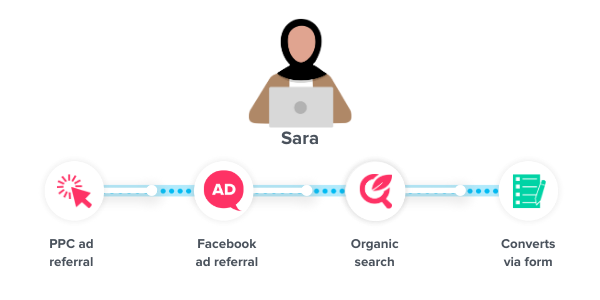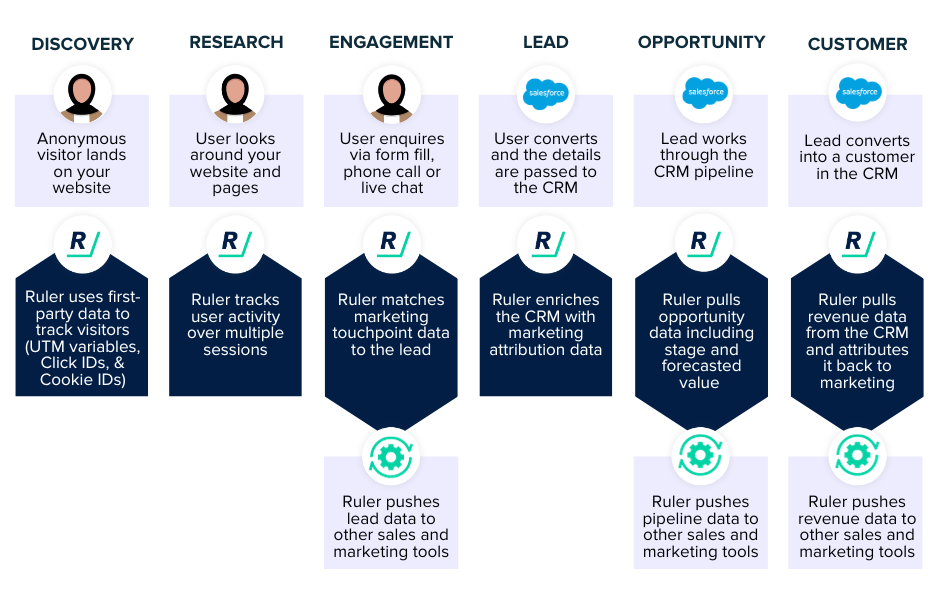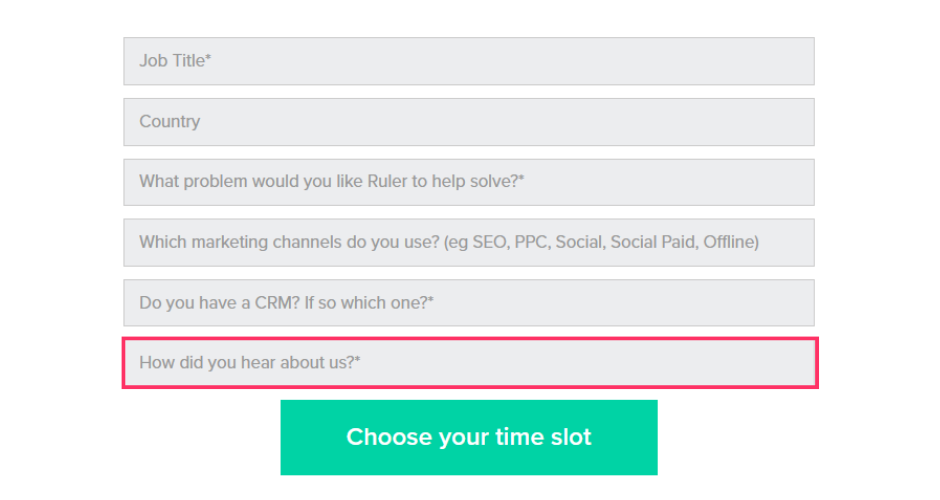Salesforce web-to-lead forms are an out of the box solution for marketers to track lead source. But are they enough? We explore the limitations of web-to-lead forms and how you can plug the gap.
91% of marketers say that lead generation is their most important goal. And it’s no surprise.
In the B2B world, lead generation is the lifeblood of any successful sales operation. However, while we found 84% of marketers use form submissions as a lead conversion tool, 36% of them struggled to accurately track them.
Salesforce web-to-lead forms offer a solution by automatically capturing lead information from website visitors and storing it in Salesforce. This information can then be used to track leads, opportunities and closed deals.
But while web-to-lead forms are a great way to capture lead information, they are not without their limitations.
In this article, we’ll discuss web-to-lead forms in Salesforce, how to set them up, the benefits they offer and how to work around some of the limitations.
What you’ll learn:
💡 Get attribution for forms, live chat and phone calls
While web-to-lead forms allow you to create and enrich leads in Salesforce with marketing source data, they’re not perfect. They don’t consider live chat or phone calls, which are also a huge opportunity for businesses. With Ruler, you can track all of your website visitors, regardless of how they interact with your business. Ruler will then send all of this data to Salesforce, so you can have a complete view of your leads, customers and their marketing sources.
See how Ruler attributes leads with attribution data
Web-to-lead is a process you can apply to your website forms that allows marketers to automatically push form submissions on their website into their Salesforce CRM.
They automatically capture visitor information and store it directly into Salesforce.
As a default, Salesforce provides the following lead sources:
Web-to-lead on your website forms automatically assign their leads under the ‘web’ category.
While you can create new lead source types for your picklist, these cannot be accurately attributed by Salesforce itself. To get an accurate lead source, you would need to integrate your CRM with an attribution tool.
Take Ruler Analytics, for example.
Ruler is a marketing attribution tool that can track all of your website visitors and marketing interactions, and then attribute the lead source to the channel, keyword, ad and landing page that was most influential in the conversion.

More on Ruler later, first let’s look at how web-to-lead forms work in Salesforce.
You can easily create Salesforce web-to-lead forms.
In Salesforce Classic, head to Setup, Customise, Leads and then Web-to-Lead. Or, if you’re using Salesforce Lightning, go to Setup, Feature Settings, Marketing and then Web-to-Lead
Once you’ve done that, you will see a short piece of HTML code.
Copy and paste the HTML code into your website. Remember, you can edit the CSS of this code if you need to.
Once this is done, whenever a user submits a form, a lead record will be created in Salesforce with the lead source ‘web’.
From there, you can send automated email follow-ups through Salesforce to nurture them through their customer journey or push them directly to a sales rep to close.
Salesforce web-to-lead forms can capture a variety of data, depending on the fields that are included in the form. By default, Salesforce web-to-lead forms capture the following data:
In addition to these default fields, you can also add custom fields to your Salesforce web-to-lead forms. This allows you to capture additional data about your leads, such as their job title, industry, or interests. Here’s how to map custom lead fields in Salesforce.
Once a lead submits a web-to-lead form, the data is automatically stored in Salesforce. You can then use this data to track leads, qualify leads, and close deals.
Don’t get us wrong, being able to automatically push your leads from your website to your Salesforce CRM is a great step.
But there are a few key issues with how web-to-lead works. Let’s discuss them one by one:
When marketers are using up to 13 different marketing channels to disseminate their content, assigning all lead forms to ‘web’ feels pretty reductive.
Related: How to track lead source in Salesforce
You can’t class organic Google, PPC and email marketing as the same source. There are different campaigns at play, different levels of time and budget, and so much more.
While web-to-lead defaulting to ‘web’ will give you an indication of the impact of your website as a whole, it doesn’t help you pinpoint what exactly is working.
While ‘web’ is too generic to really understand, even if you could get more granular detail, web-to-lead only provides you visibility of that one touchpoint.
Let’s use an example.
Sara visits your website for the first time via a PPC advert. She leaves with no further action.

A few days later, she returns via a paid Facebook ad. Again, she doesn’t convert and leaves the site.
Later, she lands on your site via an organic search. During this session, she converts into a lead by filling in a form.
Now let’s say for argument’s sake you could pull through more detail on her lead source than just ‘web’. In Salesforce, you would instead see the lead source as ‘organic’, but is this giving you the full story?
No. With just this view, you’re completely missing the impact your two paid campaigns have had on Sara’s customer journey.
💡 Quick reminder
This is where tools like Ruler come in handy. Ruler tracks every marketing touchpoint and uses this data to create a detailed view of the customer journey. This information is sent to Salesforce, which is used to identify the marketing channels that are most effective at driving leads and sales.
Download the eBook and see how Ruler enriches Salesforce
Leads are important to track. But while leads are a good indication of marketing success, they don’t guarantee sales or revenue.
While web-to-lead gives you a good insight of your lead success, your data is still siloed.
Think about it like this.
Anonymous users land on your website and engage with your content and pages. When they convert, they’re fired over to your CRM, but all of that website data remains anonymous.
That means when you come to attribute your closed revenue, you’re at a loss because you can’t access that data.
Related: How to attribute closed revenue to your marketing
When you’re missing revenue data, you’re basically marketing blind. You’re setting live and optimising campaigns based on much less actionable metrics like lead volume and clicks.
How can you get more out of your web-to-lead data? We’ve said it before, and we’ll say it again: marketing attribution is the answer.
Related: Best marketing attribution tools to integrate into your stack
Forget optimising your marketing on metrics that don’t move the needle.
With a marketing attribution tool, you can accurately determine which channels, campaigns, ads and even keywords are impacting revenue.
Let’s revisit Ruler Analytics. With Ruler in place, you can get eyes on that anonymous website data we talked about before.
Here’s how it works.

Users anonymously visit your website. Ruler users first-party data to track what content they engage with and what influenced that session.
Every time users return, Ruler will harvest that data and collect it against one single user.
When that user converts, whether that’s via form, call or live chat, Ruler will fire all of the marketing data held on them over to your CRM. Plus, you’ll be able to view their full customer journey in your Ruler report.
Related: How to track every customer touchpoint with Ruler Analytics
As the users continue to engage with you, their customer journey will grow in Ruler. Finally, when they close into a sale, Ruler will scrape the revenue data inputted into Salesforce and send it out to the relevant marketing tools.
You’ll be able to send closed sale data to tools like Google Analytics, Facebook Business Manager, Google Ads and more.
This data will be accurately attributed to the relevant channels, campaigns, ads and keywords where you can see exactly how much revenue each has contributed to.
Want to see more?
Book a demo, and we’ll show you how Ruler’s unique approach to attribution can help you make better decisions about your marketing campaigns and budget.
Book your demo with Ruler
Not every visitor will click on your site and fill in a form.
A lead may see your LinkedIn ad but not interact with it. Three days later, they may visit your website directly and convert into a lead.
Web-to-lead forms and traditional click attribution wouldn’t be able to track this interaction, as there is no click. The lead would be attributed to direct traffic, even though the LinkedIn ad likely played a key role in the customer journey.
There are two solutions you can use to sidestep this common conundrum.
The first is self-reported attribution. This involves asking leads how they heard about your business after they convert. This can be done through surveys, polls, or by adding a “how did you hear about us” field to your web forms.

The second option is marketing mix modeling. MMM is a statistical technique that uses historical data to estimate the impact of all marketing touchpoints on sales, including those that are difficult to measure, such as ad views, TV, radio, and word-of-mouth.
Ruler offers MMM alongside its multi-touch attribution. This gives marketers a better view of the impact of clicks and ad views on revenue and allows them identify the point of diminishing returns for each channel.

We have a full guide on MMM and its impact on the future of marketing measurement if you want to learn more.
Want to get more insights into your marketing impact? Finding that web-to-lead just isn’t pulling enough data through?
While it’s a popular method of capturing leads and pushing them to Salesforce, you’re missing data. By integrating a tool like Ruler Analytics into your stack, you can get a better idea of your full customer journeys and view closed revenue against channels, campaigns and even keywords.
Book a demo of Ruler Analytics to see exactly how it can supercharge the data you currently have in Salesforce.
